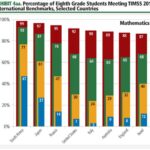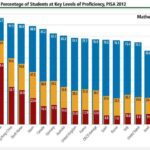Browse Resources by Year
The TIMSS study also assesses mathematics and science knowledge and skills. Unlike PISA, which focuses on broader mathematical and scientific literacy of students nearing the end of compulsory education, TIMSS is designed to align broadly with the mathematics and science curricula in participating countries at the fourth and eighth grade (approximately 9- and 13-year-old) levels.
Read MoreTrends in international primary and secondary STEM education can be compared across countries using two widely respected international exams. The Programme for International Student Assessment (PISA), carried out by the Organisation for Economic Co-operation and Development (OECD) every three years, focuses on the capabilities of 15-year-old students in mathematics and science literacy.
Read MoreHighly skilled individuals are needed to maintain the global space workforce. In most cases, these individuals will need to obtain a university degree, often in a science, technology, engineering, or mathematics (STEM) field. The number of graduates in these fields provides an indication of whether the supply of graduates will be adequate to meet industry needs.
Read MoreNot all countries collect or distribute data on agency or industry employment on a regular basis. This makes it difficult to determine trends in the global space workforce outside of a few major groups. Exhibit 4x provides a snapshot of employment in a number of space agencies in 2013. This gives some measure of the approximate size of the space programs in these nations.
Read MoreThe Japan Aerospace Exploration Agency (JAXA) employed ## individuals in 2013. This is a decrease of less than ##% from 2012. Over the past 10 years, JAXA has declined steadily, shedding ## workers since 2003—nearly ##% of its workforce. JAXA has a relatively healthy workforce age profile; ##% of its workforce is over 54 and ##% is under 35.
Read MoreIn 2012, there were ## individuals working in the Japanese space industry. This was an increase of ##% from 2011, adding ## people. At least some of this increase was due to an increase in the number of companies participating in the survey, which rose from ## in 2011 to ## in 2012. This addition continues a growth trend that began after a low point in 2008.
Read MoreThe European Space Agency (ESA) has a staff of ## employees. About half of these individuals work as engineers, scientists, or astronauts. Women make up about a quarter of ESA employees, but only ##% of science and engineering personnel. ESA has a particularly low portion of young professionals—just ##% of ESA employees are under 35.
Read MoreSpace employment in Europe has increased for the seventh year in a row, adding about ## employees from 2011 to 2012, an increase of ##%. European space employment is ##% greater than its 10-year low in 2005. Unlike the data for the U.S. space workforce, which is estimated using nationally collected data not specifically designed to capture the space industry, data on the European space workforce has been collected via a targeted survey of European space companies carried out by a not-for-profit organization, Eurospace. In carrying out this survey, Eurospace focuses on manufacturing activities and measuring end-market value.
Read MoreSpace activities are supported throughout many areas of the U.S. military, and thousands of members of the military are considered part of the space cadre. However, the National Defense Authorization Act of Fiscal Year 2012 repealed the requirement for the military to track and report to Congress the number of space personnel within the Department of Defense.
Read MoreIn 2012, NASA was ranked the best place to work in the federal government based on a survey of civil servants across federal agencies conducted by the non-profit Partnership for Public Service. In its annual survey of federal employees, the United States Office of Personnel Management found that NASA was a top performer across all four of their primary indices: leadership and knowledge management, results-oriented culture, talent management, and job satisfaction, and it was the highest-scoring agency in terms of job satisfaction.
Read More
